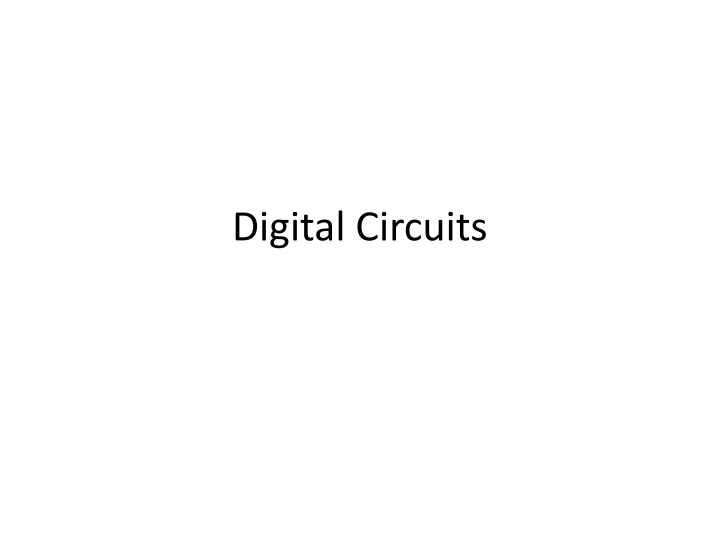
Digital Circuits and Logic Functions
Explore the process of designing digital circuits, from obtaining the truth table to converting it into circuits using logic functions. Learn how to create logic functions from truth tables and tackle logic problems with clear examples and explanations.
Download Presentation

Please find below an Image/Link to download the presentation.
The content on the website is provided AS IS for your information and personal use only. It may not be sold, licensed, or shared on other websites without obtaining consent from the author. If you encounter any issues during the download, it is possible that the publisher has removed the file from their server.
You are allowed to download the files provided on this website for personal or commercial use, subject to the condition that they are used lawfully. All files are the property of their respective owners.
The content on the website is provided AS IS for your information and personal use only. It may not be sold, licensed, or shared on other websites without obtaining consent from the author.
E N D
Presentation Transcript
Review Getting the truth table The first step in designing a digital circuit usually is to get the truth table. That is, for every input combination, figure out what an output bit should be, and write them down in a table.
Review From the truth table to circuits Any truth table can be translated into a circuits consisting of several and gates followed by one or gate. It means that any function can be implemented in this way Call a row in the truth table in which the output is `1 a ``true row and the input combination in this row a ``true input combination or just a ``true combination. Each and gate corresponds to one ``true row in the truth table. The and gate should output a `1 if and only if the input combination is the same as this row. If all other cases, the output of this and gate is `0. So, whenever the input combination is the same as one of the ``true combinations, one of the and gates outputs ``1 , so the output of the or gate is 1. If the input combination is not the same as any of the ``true combinations, none of the and gates will output a ``1 , so the output of the or gate is 0.
Logic Functions Drawing circuits is Usually we express logic functions using logic equations which are more succinct and carry the same information The OR operator is written as +, as in A + B. The AND operator is written as , as A B. The unary operator NOT is written as or A . Remember: This is NOT the binary field. Here 0+0=0, 0+1=1+0=1, 1+1=1. 6
Logic functions For example, the sum in the one-bit full adder is From a logic function you can immediately know what the circuit looks like. Truth table == Circuits == Logic function, equivalent. So we are going to get familiar with getting the logic functions from the truth table
Problems Ex 1. Assume that X consists of 3 bits, x2 x1 x0. Write a logic function that is true if and only if X contains only one 0
EX 1 X2 X1 X0 output 0 0 0 0 0 1 0 1 0 0 1 1 1 0 0 1 0 1 1 1 0 1 1 1
EX 1 X2 X1 X0 output 0 0 0 0 0 0 1 0 0 1 0 0 0 1 1 1 1 0 0 0 1 0 1 1 1 1 0 1 1 1 1 0
Ex 1 Output = x2x1x0 + x2x1 x0 + x2 x1x0
Ex 2 Assume that X consists of 3 bits, x2 x1 x0. Write a logic functions that is true if and only if X contains an even number of 0s.
EX 2 X2 X1 X0 output 0 0 0 0 0 1 0 1 0 0 1 1 1 0 0 1 0 1 1 1 0 1 1 1
EX 2 X2 X1 X0 output 0 0 0 0 0 0 1 1 0 1 0 1 0 1 1 0 1 0 0 1 1 0 1 0 1 1 0 0 1 1 1 1
Ex 2 Output = x2x1 x0 + x2 x1 x0 + x2 x1x0 + x2x1x0
Ex 3 Assume that X consists of 3 bits, x2 x1 x0. Write a logic functions that is true if and only if X when interpreted as an unsigned binary number is no less than 5.
Ex 3 X2 X1 X0 output 0 0 0 0 0 1 0 1 0 0 1 1 1 0 0 1 0 1 1 1 0 1 1 1
Ex 3 X2 X1 X0 output 0 0 0 0 0 0 1 0 0 1 0 0 0 1 1 0 1 0 0 0 1 0 1 1 1 1 0 1 1 1 1 1
Ex 3 Output = x2x1 x0 + x2x1x0 + x2x1x0
In class exercises 1 Assume that X consists of 3 bits, x2 x1 x0. Write a logic functions that is true if and only if X when interpreted as an unsigned binary number is less than 4.
In class exercises 2 Implement a circuit with three inputs (X2, X1, X0), and one output O. O should be 1 only when X2, X1, X0 are representing an odd binary number.
